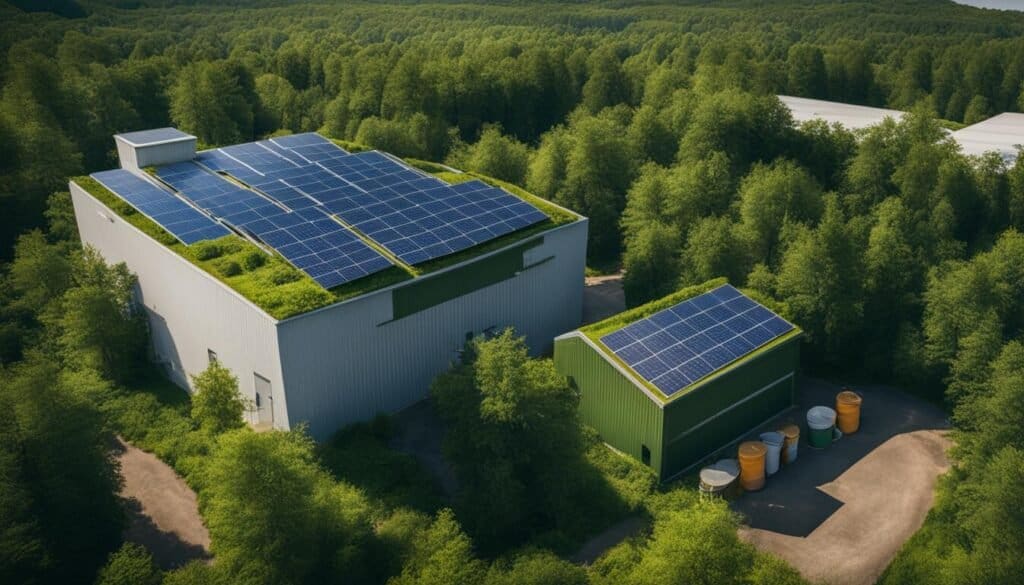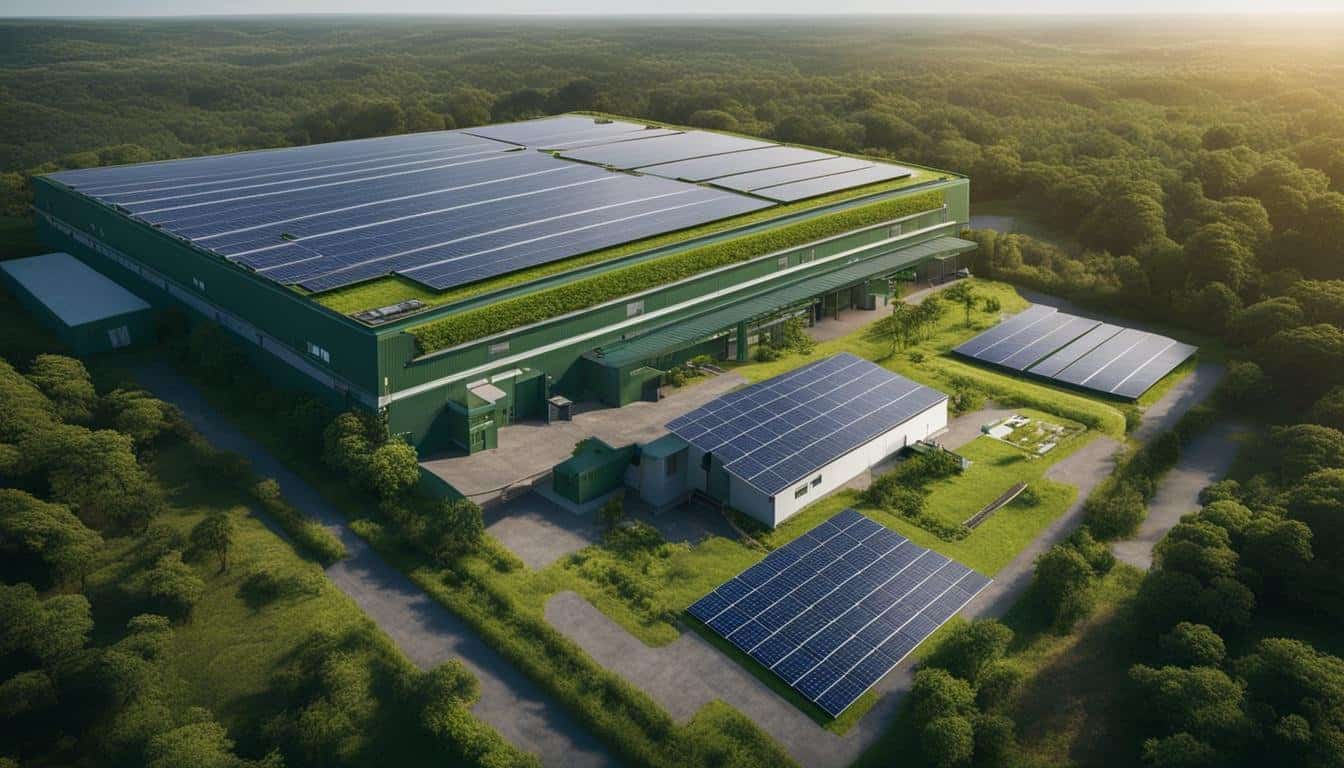As we witness an ever-growing emphasis on environmental concerns and their implications for our planet, I believe it’s essential for businesses to adapt and prioritize sustainability in manufacturing.
Adopting green manufacturing processes and sustainable business practices results in a positive environmental impact and contributes to improved efficiency, reduced costs, and enhanced reputation for companies. This article will explore the importance of green manufacturing, its many benefits, and how we can implement these eco-friendly practices in the manufacturing sector.
Key Takeaways
- Green manufacturing processes contribute to reduced environmental impact and increased sustainability in manufacturing.
- Eco-friendly manufacturing techniques lead to cost savings, better brand perception, and business competitive advantages.
- Transitioning to sustainable business practices involves adopting alternative energy sources, waste reduction strategies, and energy-efficient technologies.
- Manufacturing sustainability is crucial for a company’s long-term growth and alignment with consumer expectations.
- Real-world examples and case studies depict the successful implementation of green manufacturing practices and their benefits.
Understanding Green Manufacturing and Its Importance
Green manufacturing is defined as a responsible approach to production that minimizes the use of environmental pollutants and natural resources while striving to produce minimal waste and emissions. As our society becomes increasingly aware of the importance of eco-friendliness and sustainability, businesses must recognize the value of implementing green manufacturing processes. It underscores the production of goods in a manner that has a reduced impact on the natural environment.
Let’s delve into the importance of green manufacturing by examining some key aspects that make it a crucial consideration for businesses aiming for sustainable long-term growth.
- Conservation of energy and alternative energy use: Green manufacturing focuses on reducing energy consumption through efficient processes, practices, and equipment. Additionally, it encourages using alternative renewable energy sources like solar, wind, or hydropower.
- Reduction of environmental pollutants: Environmentally friendly manufacturing methods aim to eliminate or minimize pollutants released into the environment. For example, green production might involve installing scrubbers and filters that reduce harmful emissions and air contaminants.
- Incorporation of non-toxic materials: Green manufacturing emphasizes safe, sustainable, and recyclable choices. This can include selecting non-toxic raw materials or opting for packaging made from sustainable sources.
- Recycling and waste reduction: Implementing recycling and waste management programs in production is fundamental to green manufacturing. It reduces the amount of waste generated and promotes material conservation.
It’s clear that green manufacturing has a significant role in the future of business and industry, as it addresses pressing environmental concerns and offers numerous benefits for businesses that invest in eco-friendly practices.
Green Manufacturing: A Strategic Business Advantage
Today’s businesses quickly realize the potential of incorporating green manufacturing practices into their operations. From enhancing brand image to gaining a competitive edge in an eco-conscious market, sustainable manufacturing brings a plethora of benefits that contribute to the bottom line and foster a more responsible approach to the environment.
Boosting Brand Image and Customer Loyalty Through Green Practices
Adopting green business practices has become an effective way to elevate a company’s reputation and image. Consumers increasingly prioritize environmental responsibility, with 37% considering a product’s ecological impact when purchasing. A solid commitment to sustainability and eco-friendly manufacturing practices can significantly enhance brand image, attracting loyal customers who value such initiatives.
Sustainable manufacturing involves using renewable energy, encouraging diverse workforce participation, and implementing lean processes to lower waste, attracting stakeholders and customers. – Manufacturing Digital
Leading companies such as Patagonia and Tesla have built strong customer loyalty with their sustainable product designs and ethical business practices.
Beyond attracting new customers, a positive brand image centered around green manufacturing can also lead to tangible growth in sales, as environmentally conscious consumers are more than willing to support businesses that align with their values.
Innovating for Competitive Edge in the Eco-Conscious Market
Innovation and adopting green technologies play a crucial role in giving manufacturers a competitive edge in the increasingly eco-conscious market. Embracing sustainability can stimulate innovation in product design and manufacturing processes, leading to increased productivity, reduced lead times, and greater operational efficiency.
- Utilizing cutting-edge technologies to track overall equipment effectiveness (OEE)
- Optimizing resource utilization by minimizing waste and increasing recycling efforts
- Investing in renewable energy solutions for more sustainable manufacturing plants
Companies prioritizing green manufacturing practices position themselves better to meet the rising demands of consumers who prefer products that align with their environmental values.
| Company | Innovative Green Technology | Impact on Business |
|---|---|---|
| Siemens | Wind turbine technology | Increased market share in renewable energy sector |
| Unilever | Zero waste manufacturing plants | Reduced operational expenses and waste disposal costs |
| Nestlé | Water conservation initiatives | Improved environmental reputation and reduced water usage |
As the world moves toward a more sustainable future, businesses that take the initiative to incorporate green manufacturing practices and sustainable product designs are likely to thrive in an increasingly competitive, eco-conscious market.
The Economic Impact of Sustainable Manufacturing on Businesses
The economic impact of sustainable manufacturing on businesses is significant. Companies can achieve various advantages by adopting sustainable practices, including cost reductions and increased profitability. This, in turn, fosters a competitive edge in the market while also promoting environmental stewardship.

Energy-efficient initiatives, such as replacing incandescent bulbs with LEDs and using EnergyStar appliances, can considerably reduce operational expenses. Furthermore, resource optimization and managing waste effectively can lead to additional cost savings, making sustainable manufacturing an attractive option for firms.
In a notable study, one company saved $7 billion through sustainable manufacturing, while another saved $80 million annually by reducing energy use.
Additionally, sustainable manufacturing can provide tax advantages. Incentives in the form of credits and deductions are available for businesses investing in green technologies, further encouraging adoption of eco-friendly practices.
- Cost savings through energy-efficient initiatives
- Resource optimization for increased efficiency
- Reducing operational expenses and increasing profitability
- Tax incentives for green technology investments
- Supporting the local economy by sourcing materials and services locally
Green practices often align with reshoring trends, providing opportunities for locally sourced materials and services. This can result in lower distribution costs and support the local economy, increasing the attractiveness of sustainable manufacturing for businesses.
| Practice | Benefit |
|---|---|
| Energy-efficient initiatives | Reduced operational expenses |
| Resource optimization | Increased efficiency and profitability |
| Waste reduction | Cost savings and environmental benefits |
| Green technology investments | Tax incentives and long-term savings |
| Local sourcing | Lower distribution costs and support for the local economy |
Sustainable manufacturing offers numerous economic benefits for businesses. Implementing green practices can lead to cost savings, increased profitability, and a stronger competitive position in the market. Furthermore, investing in green technologies and locally sourced materials can provide tax incentives and support the local economy. As more companies recognize the value of sustainable manufacturing, its economic impact and potential for positive change will only continue to grow.
How Green Manufacturing Influences Environmental Impact
Green manufacturing significantly influences the environmental impact of traditional manufacturing processes by reducing carbon emissions, waste, and pollution. Adopting eco-conscious manufacturing tactics, such as resource efficiency and green production practices, can contribute to a substantial reduction of carbon footprint.
Using sustainable materials and renewable energy sources aids in lowering the carbon footprint of manufacturing companies.
Efficient use of resources and mindful waste management contribute to a more minor ecological impact, aligning with consumer expectations and likely policy shifts toward stricter environmental regulations. Innovative approaches to manufacturing, such as using sustainable materials, renewable energy sources, and green production practices, are crucial for companies to evolve and mitigate their environmental impact.

The circular economy concept is garnering attention as a viable approach to sustainable manufacturing. One example is Sierra Nevada’s composting of brewing waste, which enhances soil fertility and demonstrates how green manufacturing can foster environmental conservation and reduce the overall negative impact of production.
- Resource efficiency: Optimizing the use and consumption of raw materials.
- Green production practices: Implementing processes to minimize energy, waste, and emissions.
- Sustainable materials: Utilizing renewable and recyclable resources for product manufacturing and packaging.
- Waste management: Developing strategies for reducing, reusing, and recycling waste products.
- Renewable energy: Incorporating clean energy sources, such as solar or wind power, in manufacturing facilities.
Adopting these strategies enables manufacturers to drastically reduce their environmental impact while simultaneously enhancing their reputation as responsible, sustainable businesses. It is crucial for companies to recognize the importance of eco-conscious manufacturing and act accordingly to invest in cleaner, green technologies that not only benefit their bottom line but also preserve the planet for future generations.
Implementing Sustainable Business Practices in Manufacturing
The journey toward becoming a green manufacturer begins with recognizing and analyzing the current environmental impact of manufacturing practices. It involves conducting energy, waste, and water audits to identify opportunities for improvement. Implementing sustainable solutions, such as energy-efficient lighting, water conservation, and recycling measures, constitutes the initial stages of this process. Gradual implementation of cleaner, safer materials and leveraging excess or recyclable raw materials are also steps toward greener production. Emphasizing transparency and continuously making strides toward greener practices can progressively transform a manufacturing company into a sustainable, eco-friendly entity.

The Journey Toward Becoming a Green Manufacturer
- Recognize and analyze: Begin by understanding the current environmental impact of your operations and identify areas with potential for improvement.
- Audits: Conduct energy, waste, and water audits to determine inefficiencies and devise remediation strategies.
- Implementation: Prioritize and implement sustainable solutions such as energy-efficient lighting systems, water conservation practices, and recycling programs.
- Materials: Gradually replace traditional materials with cleaner, safer alternatives and efficiently utilize excess or recyclable raw materials.
- Transparency: Ensure transparency in your company’s green transition journey, engaging internal and external stakeholders throughout the process.
During the green transition journey, companies should keep track of their key performance indicators (KPIs) to measure progress. The following table highlights specific KPIs and relevant target action points for environmental practices implementation in the manufacturing industry:
| KPI | Target Action Point |
|---|---|
| Energy consumption | Replacement of old equipment with energy-efficient alternatives, adoption of renewable energy sources |
| Waste generation | Waste minimization strategies, recycling programs, and partnerships with local businesses to share or recycle excess materials |
| Water usage | Water conservation practices, leak detection, and efficient equipment for reduced water consumption |
| Greenhouse gas emissions | Implementation of energy-efficient technologies and adherence to emissions standards |
| Supply chain sustainability | Sourcing from certified and eco-friendly suppliers, emphasizing locally produced materials and services |
“We do not inherit the Earth from our ancestors; we borrow it from our children.” – Native American proverb
By embarking on a sustainable production pathway, companies can achieve a balanced integration of environmental, social, and economic considerations, benefiting the planet, communities, and the bottom line. As global attention increasingly turns toward environmental responsibility, the time is ripe for manufacturers to prioritize sustainability and secure their success in a rapidly evolving industry landscape.
Evaluating the Benefits of Sustainable Materials and Energy Use
Incorporating sustainable materials and renewable energy sources in manufacturing offers many benefits for businesses, consumers, and the planet. These include cost savings, reduced pollution, environmental preservation, and alignment with consumer preferences.

- Cost savings: Utilizing renewable energy sources like solar, wind, geothermal, hydropower, and landfill gas can result in significant cost reductions over time, even if initial investments may be required. In addition, sustainable materials often require less maintenance and can last longer compared to conventional alternatives.
- Environmental preservation: Sustainable materials and energy sources aid in reducing pollution, conserving natural resources, and minimizing overall environmental impact. These eco-friendly choices support sustainable production and contribute to a healthier planet.
- Consumer preference: More and more consumers prioritize the environmental aspects of the products they buy, leading to increased demand for goods made from sustainable materials and produced using renewable energy sources. Businesses that embrace these environmentally conscious practices can attract a broader customer base, supporting both their financial objectives and sustainability goals.
Notable companies like Patagonia have demonstrated the environmental benefits of sustainability through their use of recycled materials and renewable energy. Incorporating these eco-friendly solutions has resulted in both cost savings and a positive brand image, showcasing the value of sustainable manufacturing practices.
| Company | Initiatives | Outcome |
|---|---|---|
| Patagonia | Recycled materials; renewable energy use | 94% of 2020 product line made from recycled inputs; reduced environmental impact |
| IBM | Energy conservation in manufacturing | Reduced carbon footprint; operational cost savings |
“Sustainable materials and renewable energy use play an essential role in meeting consumer demand, improving resource efficiency, and fostering a healthier planet.”
The benefits of using sustainable materials and renewable energy sources span from energy conservation in manufacturing to cost savings and positive brand perception. As manufacturers adopt environmentally responsible practices, society will reap the advantages of greener, more sustainable production.
Adopting Green Technologies in the Manufacturing Sector
The manufacturing sector has an opportunity to make significant strides toward sustainability by adopting green technologies, such as solar panels and wind turbines. Plows can operate more sustainably and contribute to environmental conservation by reducing reliance on non-renewable energy sources.
Implementing renewable energy solutions, like solar and wind power, not only helps to achieve a more sustainable manufacturing plant but also offers a range of financial benefits. Manufacturers can enjoy cost savings and tax incentives, making adopting green technology economically attractive.
Renewable Energy Solutions for A Sustainable Manufacturing Plant
Companies such as Walmart and Anheuser-Busch InBev have adopted renewable energy systems for both economic reasons and to decrease their environmental footprints. Implementing these technologies can lead to lower operational costs and financially appealing incentives at both state and national levels, making renewable energy an attractive option for manufacturers looking to become more eco-friendly.
Utilize renewable energy sources, like solar panels, for powering operations to reduce carbon footprint and cut energy costs. – Green Business Bureau
Investing in renewable energy solutions can lead to long-term cost savings, tax incentives, and improved brand reputation in the marketplace.
Embracing energy-efficient technology adoption and green energy in production helps organizations align their manufacturing processes with their sustainability goals. Here are a few examples of renewable energy solutions that can be integrated into a manufacturing plant:
- Solar panels: Harnessing the sun’s power to generate electricity and reduce dependence on fossil fuels.
- Wind turbines: Capturing wind energy and converting it into electricity, offering an environmentally friendly alternative for power generation.
- Geothermal systems: Utilizing the Earth’s internal heat as an energy source, providing constant, renewable power for heating and cooling systems.
- Hydroelectric power: Generating electricity from running or falling water offers a clean, dependable energy source.
- Biomass energy: Converting organic waste materials (such as wood and agricultural waste) into energy through combustion or other conversion processes.
| Renewable Energy Solution | Benefits |
|---|---|
| Solar panels | Reduced dependence on fossil fuels; potential cost savings |
| Wind turbines | Environmentally friendly power generation; potential cost savings |
| Geothermal systems | Constant, renewable energy; reduced emissions |
| Hydroelectric power | Clean, dependable energy source; potential cost savings |
| Biomass energy | Conversion of waste materials into usable energy; reduced landfill usage |
The adoption of green technologies in the manufacturing sector promises to drive economic and environmental benefits for both businesses and the planet. As manufacturers continue to seek innovative ways to reduce their impacts, integrating renewable energy solutions becomes a central component of building a genuinely sustainable manufacturing plant.
Reducing Waste and Pollution: Green Manufacturing Best Practices
Implementing green manufacturing best practices is essential to reduce waste and pollution, which contributes to sustainable operations. These practices benefit the environment and enhance cost-efficiency across the manufacturing process.
- Efficient resource utilization
- Comprehensive waste management initiatives
- Collaborations with local businesses
- Regular monitoring and transparent documentation
Simple measures such as turning off lights when not in use and recycling materials significantly reduce energy use and material waste. Manufacturers can also employ energy-efficient technologies and adopt waste reduction methodologies for a more sustainable operation.

Collaboration between local businesses enables effective waste management and resource sharing. For instance, excess or recyclable resources from one manufacturer can be utilized by another company, thus reducing the need for disposal and cutting down waste generation.
| Resource | Waste Reduction Method |
|---|---|
| Energy | Use energy-efficient lighting and equipment |
| Water | Implement water conservation strategies |
| Materials | Opt for reusable or recyclable materials |
Monitoring and transparent documentation of waste reduction efforts help ensure accountability and steady progress toward minimizing environmental pollution and waste generation. Employing regular audits can identify areas of improvement and provide a clear road map for a more sustainable manufacturing operation.
“Sustainability is the key to our survival on this planet and will also determine success on all levels.”
– Shari Arison, businesswoman and philanthropist.
Green manufacturing best practices contribute to pollution prevention, reduced waste generation, and sustainable business operations. By implementing effective waste management initiatives and continually identifying and addressing areas of improvement, manufacturers can adapt to increasingly eco-conscious markets and create a greener, more sustainable future.
Ensuring a Sustainable Supply Chain in Manufacturing Industries
Ensuring a sustainable supply chain is a critical aspect of green manufacturing, particularly in manufacturing industries with substantial environmental impact. By sourcing materials responsibly, engaging with suppliers dedicated to sustainability, and adopting green supply chain initiatives, manufacturers can reduce their carbon footprint and contribute to global environmental conservation efforts.
One vital aspect of a sustainable supply chain is sustainable sourcing, which involves obtaining materials from renewable, recycled, or certified sources. For example, using Forest Stewardship Council-certified wood in furniture production can help prevent deforestation and promote responsible forest management. Similarly, selecting suppliers that use recycled materials in their products supports the circular economy and minimizes waste.
“Manufacturers must prioritize sustainable sourcing and engage with suppliers that share a commitment to sustainability.”
Another essential aspect of a sustainable supply chain lies in utilizing lean manufacturing principles, optimized by AI and the Internet of Things, to minimize waste and reduce energy consumption. This eco-friendly supply management practice allows companies to incorporate environmental considerations into every stage of their supply chain, from sourcing materials to manufacturing and distribution.
Furthermore, the shift towards local sourcing is gathering steam as buyers and businesses acknowledge its benefits, such as reduced transportation costs and a smaller carbon footprint. By procuring materials and services closer to a manufacturing facility, companies can not only lessen their environmental impact but also support the local economy and reduce the reliance on imported goods.
- Identify and engage with sustainable suppliers
- Source materials from renewable, recycled, or certified sources
- Optimize production processes using lean manufacturing principles and emerging technologies
- Collaborate with suppliers to implement green supply chain initiatives
- Adopt local sourcing whenever possible to reduce transportation distances and carbon emissions
Companies should prioritize eco-friendly supply management practices to ensure a sustainable supply chain in manufacturing industries. By embracing responsible sourcing, lean manufacturing principles, and local collaboration, businesses can build a greener future for the planet and generate lasting benefits for all stakeholders.
Exploring the Relationship Between Green Manufacturing and Lean Manufacturing
When it comes to sustainable business practices, the relationship between green manufacturing and lean manufacturing is of utmost importance. These two methodologies share a common goal: improving efficiency and reducing waste in the manufacturing process.
However, green manufacturing goes a step further by focusing on environmental responsibility, resulting in a lean and green approach to production. This strategic combination benefits the efficiency of production processes and demonstrates a company’s dedication to environmental stewardship.
Marrying Efficiency with Environmental Responsibility in Production Processes
Traditionally, lean manufacturing aims to eliminate waste and enhance financials by optimizing processes and streamlining workflows. However, with growing concern for environmental conservation, lean methodologies have evolved to incorporate green initiatives. Integrating AI and IoT has further optimized these methodologies, enabling lean practices to support sustainable production practices.
Lean and green manufacturing aligns operational efficiency with eco-conscious measures, such as reduced resource usage and environmentally friendly materials.
By merging lean manufacturing principles with green manufacturing practices, businesses can achieve a balanced approach to production that optimizes efficiency while prioritizing environmental responsibility. To illustrate the benefits of this approach, consider the following table that compares traditional lean manufacturing with lean and green manufacturing:
| Aspect | Lean Manufacturing | Lean and Green Manufacturing |
|---|---|---|
| Goal | Eliminate waste and improve efficiency | Eliminate waste, improve efficiency, and minimize environmental impact |
| Resources | Optimize resource usage | Optimize resource usage and promote use of sustainable resources |
| Waste Management | Reduce wastage and related costs | Reduce wastage, related costs, and promote recycling and eco-friendly disposal methods |
| Environmental Impact | Not a primary focus | Minimize negative environmental impact and promote eco-conscious practices |
Adopting lean and green manufacturing enables businesses to become more cost-effective, productive, and environmentally responsible. This evolving approach to production demonstrates that operational efficiency and environmental stewardship can coexist, providing a blueprint for sustainable business success in the modern manufacturing landscape.
Case Studies and Examples of Successful Green Manufacturing Companies
Throughout the manufacturing industry, there are inspiring green manufacturing case studies and examples of eco-friendly companies demonstrating the effectiveness and benefits of adopting sustainable practices. By learning from these successful green manufacturers, other businesses can develop effective strategies for implementing green practices in their own operations. Let’s examine some sustainable manufacturing success stories and their noteworthy green company achievements.
- Sierra Nevada Brewing Co.: Known for its sustainable brewing practices, Sierra Nevada has implemented various eco-friendly measures, such as using solar power, recycling water, and reusing waste. One particular achievement is their composting program, which takes brewing waste and enriches soil with it, supporting local agriculture.
- Patagonia: This outdoor clothing and gear company has long been a champion of sustainable and ethical manufacturing. In 2020, an impressive 94% of their product line was created using recycled inputs, showcasing their commitment to reducing the environmental impact of their products.
- Siemens AG: As a global technology powerhouse, Siemens has focused on providing renewable energy solutions to facilitate sustainable power generation. With innovations in wind, solar, and hydroelectric power, Siemens is helping manufacturing companies minimize their reliance on non-renewable energy sources.
These companies exemplify excellence in green manufacturing implementation, going above and beyond industry norms. Their commitment to adopting sustainable manufacturing principles and investing in eco-friendly solutions demonstrates that integrating green practices into business operations can lead to improved environmental outcomes and long-lasting success.
Although only a handful of companies are currently making headlines for their outstanding green manufacturing efforts, these success stories illustrate the potential for transformative change in the industry. As more and more businesses embrace sustainability and adopt eco-friendly practices, there is no doubt that the manufacturing sector will continue to evolve, with a growing focus on environmental stewardship and responsible production.
Conclusion on Green Manufacturing benefit
As we have seen, the importance of green manufacturing in the current business landscape cannot be overstated. With an increasing emphasis on environmental sustainability and the growing consumer demand for eco-friendly products, it is vital for businesses in the manufacturing sector to adopt sustainable practices. The shift towards green manufacturing not only addresses the urgent need for environmental preservation but also offers a host of economic benefits, such as cost savings, improved brand perception, competitive advantages, and increased shareholder value.
Throughout this article, we explored various case studies and examples of successful green manufacturing companies, serving as inspiring models for others looking to integrate sustainability into their operations. Companies like Sierra Nevada, Patagonia, and Siemens AG have demonstrated that green manufacturing processes can be effectively implemented and yield significant results in terms of environmental and economic benefits.
As the manufacturing industry continues to evolve, a commitment to eco-friendliness and sustainability will play a crucial role in the success of businesses and the well-being of our planet. By embracing this sustainability mission, we help shape the future of manufacturing to be greener, cleaner, and more responsible for generations to come.
FAQ on the Green Manufacturing Processes
Q: What is the role of sustainability in the manufacturing process?
A: Sustainability in the manufacturing process involves the renewal of production processes and the establishment of environmentally-friendly operations within the manufacturing field. It seeks to use fewer resources, generate less waste, and contribute less to environmental degradation, while still offering high-quality products and services.
Q: Can manufacturing truly be sustainable?
A: Yes, manufacturing can be sustainable. Many businesses are already implementing green manufacturing practices that focus on reducing waste, optimizing logistics, and promoting the use of renewable energy. Such operations within the manufacturing field are increasingly crucial for the sustainability of our planet and the economy.
Q: What is green manufacturing and what is its significance?
A: The green manufacturing definition refers to the process of manufacturing goods in a way that minimizes damage to the environment. In other words, it’s about designing, producing, delivering, and recycling products in a way that uses fewer resources, causes less pollution, and creates less waste. Green manufacturing is significant because it contributes to the sustainability of the planet and helps many businesses improve efficiency and reduce costs.
Q: How does going green affect businesses?
A: Going green can greatly benefit businesses. Some of the benefits of green manufacturing include cost savings, improved brand reputation, better compliance with regulations, and increased customer loyalty. Furthermore, many businesses believe that going green will push them to innovate and remain competitive in the marketplace.
Q: Can manufacturing software contribute to green manufacturing?
A: Yes, manufacturing software can significantly contribute to green manufacturing by helping businesses monitor and reduce their environmental footprint. The software can track energy use, waste generation, and emissions, helping businesses become green and sustainable over time.
Q: What are the benefits of green manufacturing?
A: The benefits of green manufacturing are manifold. They include reduction in waste generation and energy consumption, as well as improvement in resource use efficiency. Green manufacturing also aids in risk management, contributes to reputation enhancement, and helps many businesses achieve regulatory compliance.
Q: How can manufacturers research on “green” options and integrate them into their production processes?
A: Green manufacturers research involves evaluating all aspects of their operations to identify areas where they can become more sustainable. This involves looking at raw material sourcing, production processes, energy use and disposal. Waste management and recycling programs can also be a part of the solution. The results of the research can then be integrated into their production processes to increase efficiency, reduce waste, and decrease environmental impact.
Q: Why should businesses invest in environmentally-friendly operations within the manufacturing field?
A: Investments in environmentally-friendly operations within the manufacturing field are crucial for a variety of reasons. Beyond the obvious environmental reasons, there are also significant cost reduction opportunities, as eco-friendly operations often result in lower utility bills, less waste, and reduced costs for raw materials. Additionally, going green can enhance a company’s image, making it more attractive to consumers and investors.
Q: Can businesses go green and still be profitable?
A: Yes, businesses can certainly go green and remain profitable. Green manufacturing often leads to cost savings in the long term by reducing energy use, minimizing waste and improving efficiency. Further, customers are increasingly looking for environmentally responsible products, which can result in higher sales and improved profitability for businesses that commit to going green.
Q: How can manufacturers integrate green practices in their product cleaning processes?
A: Green cleaning products can be used as a part of an eco-friendly manufacturing process. These products are typically made without toxic or harmful chemicals and are therefore safer for both workers and the environment. Also, manufacturers can adopt cleaning processes that use less water and energy, further contributing to overall sustainability.





Leave a Reply